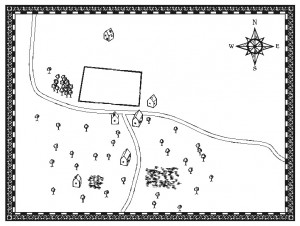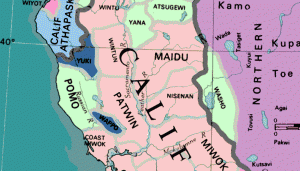Locations: Garnoc’s Gloves
Garnoc is one of Trizol’s premier gloves makers. His shop is located in the city of Newhaven Crossing. His clientele are mostly nobles and rich military officers. He has experience in making a wide variety of leathers into functional and good looking gloves.
Garnoc himself is getting on in age and currently has two apprentices working for him, twin brothers named Markoos and Harkoos. These apprentices stand to jointly inherit the shop when he dies. Although both are very skilled and handle the bulk of the orders coming through the shop, Garnoc has not yet sponsored them to the Guild.
The shop is on the corner of Dragon’s Rest and an unnamed alleyway. It’s a small two story affair that is well kept up. In the back it shares a common area with several other shops and houses. It also shares a dirty stable with the inn next door, although Garnoc does not have any animals at this time.
When entering from the front door, gloves are neatly arranged on shelves. They are sorted by material, size and color. Each pair is left unfinished so that they can be custom fitted to the customer. A glass case against one the interior wall also serves as a sales counter. Displayed inside are some of the more exotic materials, including a set made from black dragon leather. All gloves are masterwork in quality but confer no other game stats unless created to do so by another NPC or PC at DM’s discretion. Prices range from 7gp for basic leather riding gloves to 600gp for the black dragon ones.
A door way covered with a simple curtain separates the front from the workshop in back. It is about twice the size of the front showroom, about fifteen by thirty feet. Bolts of leathers of all types are neatly shelved (about 6000gp worth) along one long wall. A work bench lines the other side. All tools are in their place and the only scraps are from projects currently in progress. At the far end is a small stove for heat. Closest to the door is a comfortable chair for clients to sit in while their hands are measured for custom orders.
Small stairs near the stove lead to the upstairs. It has been divided into four rooms. The twins share one, Garnoc has another and the other two are full of miscellaneous household supplies and broken tools from the shop below. Garnoc has about three hundred gold hidden in his room (search 15) in various sized coins. It is protected by a magic trap (disable device 25) that freezes (DC:30 save) any would-by thieves.
Garnoc is about 65 years old. He has a full head of greying hair but walks with a slight stoop. He is always immaculately dressed in one of six nice suits that he owns. All are several generations out of style. Over this he wears a leather apron when working in the shop.
Stats: male human commoner; CR 3; HD 3d4+3; hp 11; Init +0; Spd 30 ft; AC 10, touch 10, flat-footed 10 BAB +1; (1d10+3/x3); AL LG; SV Fort +2, Ref +1, Will +0; Str 8(-1), Dex 10(+0), Con 12(+1), Int 11(+0), Wis 9(-1), Cha 14(+2).
Skills and Feats: HIDE+0, SPOT+2(3), LISTEN-1, MOVE SILENTLY+0, climb+6(4), craft(leatherworking)+6(6), appraise+4(2), use rope+3(3).
Markoos and Harkoos are identical twins. Both are dark haired, about five and a half feet tall. Their age is somewhere between fourteen and seventeen, but they’re not sure. Their parents were killed by bandits and the twins found themselves in a strange city with no support. Even Garnoc is not sure why he took them in, but they have proven to be well worth his trouble. He looks upon them as the sons he never had and is extremely proud of them, although does not show it, merely commenting upon their skills and efficiency.
Twins stats: Human Male, Com1; CR 1; HD 1d4+1; hp 5; Init +0; Spd 30 ft; AC 10, touch 10, flat-footed 10 BAB +0; Melee club +3 (1d6+2); AL LG; SV Fort +1, Ref +0, Will -2; Str 14(+2), Dex 10(+0), Con 13(+1), Int 12(+1), Wis 7(-2), Cha 16(+3).
Skills and Feats: HIDE+0, SPOT-2, LISTEN-2, MOVE SILENTLY+0, craft(Leatherworking)+6(4), escape artist+2(2), heal+1(4), swim+4(2); simple weapon proficiency(club), track.
Adventure seeds:
- Garnoc had a falling out with the guild sometime ago. Due to his skills and Noble patronage it has not affected his business much, but with his increasing age and closing retirement the Guild is looking to change that.
- The twins recognizes one of the bandits who killed their parents in a nearby tavern. The man has recently moved into the city, reformed his ways and taken up an honest trade. But the twins want revenge for what he did.
- A single glove was found at the scene of a horrific crime. It is clearly one of Garnoc’s creations. The problem is he never sold that pair. Or perhaps he simply does not remember who he sold them too.
- The night before Garnoc is set to sponsor the twins to the Guild, he dies. Some of the more jealous Guild members see this as an opportunity to take over the profitable and reputable shop. Markoos and Harkoos are distraught over this news and vow to fight however they can, but being merely apprentices, they have no standing in the Guild.
- A mysterious woman brings in an a piece of extremely rare leather and asks for a pair of gloves. She does not give a name, but leaves an address in the Mage’s district to deliver them too. That night the shop is broken into and only that piece of leather is stolen. The Constable reports that magic, rather then thief skills were used.



